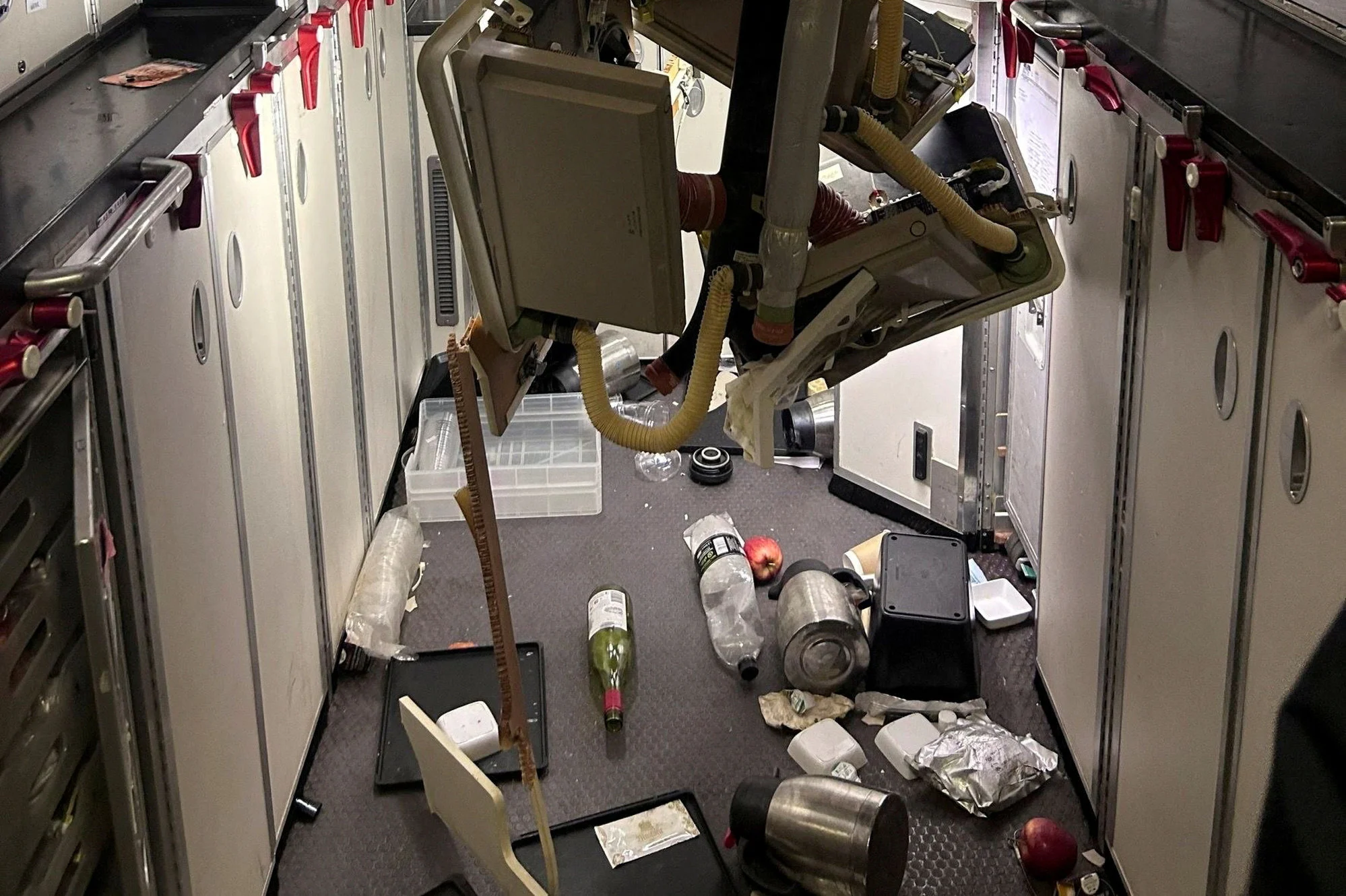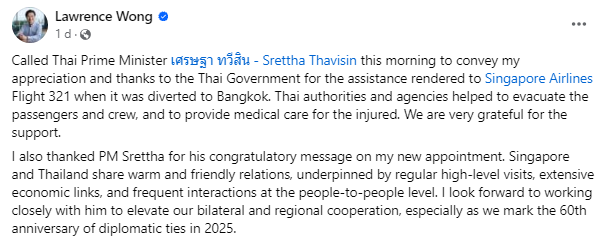Imagine you are eagerly onboard a flight to your vacation spot, and everything seems normal. Suddenly, you hit a patch of extreme turbulence, and it becomes a roller coaster ride you did not sign up for.
That was exactly what happened on 21 May 2024, when a flight from London to Singapore experienced severe turbulence, causing injuries and, unfortunately, one passenger’s death due to a suspected heart attack.
The Singapore Transport Ministry recently released some initial findings that shed light on what went down.
What Exactly Happened to Flight SQ321?
The Ministry of Transport (MOT) said that their Transport Safety Investigation Bureau (TSIB) looked at data from the plane’s flight data recorder and cockpit voice recorder.
A team of experts from Singapore, the US National Transportation Safety Board, the Federal Aviation Administration, and Boeing analyzed this data to understand what happened.
They found that everything was normal after Singapore Airlines flight SQ321 left London. However, at 7:49AM UTC (3:49PM in Singapore) on 21 May, when the plane was flying over southern Myanmar at 11,300 meters, it likely hit some bad weather, called “developing convective activity”.
This is a fancy term for a weather condition where heat causes air to rise, creating turbulence.
Now, let’s explain what happened during the turbulence, step by step:

- G-Force Fluctuation:
- The G-force changed between 0.44G and 1.57G over 19 seconds. Normally, passengers experience G-forces between 0.7G and 1.3G. This means the plane started to shake a bit.
- Altitude and Airspeed Changes:
- Around the same time, the plane’s altitude unexpectedly climbed to 37,362 feet. The autopilot tried to fix this by making the plane go back down to 37,000 feet. The pilots also noticed the plane was speeding up without them telling it to. They used speed brakes to slow it down.
- Fasten Seat Belt Sign Turned On
- Eleven seconds after the shaking started, one of the pilots announced that the seat belt sign was on. This was because the plane was being pushed up by an updraft (rising air).
- Rapid G-Force Change:
- Just eight seconds after the altitude spike, the G-force changed rapidly again. The vertical acceleration went from 1.35G to -1.5G in just 0.6 seconds, causing unbelted passengers, crew and loose items to be thrown into the air. One second later, the G-force swung back from -1.5G to 1.5G over four seconds, slamming those airborne passengers back down. These rapid changes caused the plane to drop 178 feet and led to the injuries.
A change of 3G is quite a lot for the human body. To put it in perspective, a former Singapore Airlines pilot compared it to a roller-coaster drop, where you experience rapid ups and downs that can be quite jarring.
For reference, the world’s fastest roller coaster in Dubai goes up to 4.8G, and fighter pilots can handle 5 to 9Gs, but they have special equipment and seat belts to keep them safe.
During these G-force changes, the pilots manually took control of the plane for 21 seconds to stabilize it and then turned the autopilot back on at 7:50AM UTC.
After the pilots re-engaged the autopilot, the G-forces gradually changed between 0.9G and 1.1G. The plane returned to its normal altitude of 37,000 feet within 18 seconds.
When the cabin crew informed the pilots that there were injured passengers, they decided to divert the flight to Suvarnabhumi Airport in Bangkok, Thailand in order to seek medical attention. They requested help to meet them upon arrival.
17 minutes after the turbulence, at 8:06AM UTC, the pilots began a controlled descent from 37,000 feet, reaching 31,000 feet by 8:10AM UTC. The plane didn’t encounter more severe turbulence and landed safely in Bangkok at 8:45AM UTC.
In summary, the plane encountered some severe weather which caused sudden and unexpected changes in altitude and speed, leading to a rough ride that injured many passengers.
The pilots managed the situation well, stabilizing the plane and diverting to Bangkok for an emergency landing to get help for the injured.
Professor Rico Merkert, an aviation expert at the University of Sydney, emphasized that despite the scary nature of the turbulence, it’s impressive how well modern aircraft can handle such conditions.
He assured that wearing seat belts during turbulence generally keeps passengers safe. He pointed out, however, that turbulence during meal times or when passengers are using the restrooms poses different challenges, but these periods can be minimized.
As to why it took 19 seconds before the pilots turned off the autopilot, experts explained that autopilot systems are already designed to manage most turbulence.
Shantanu Gangakhedkar, a senior consultant at Frost and Sullivan, mentioned that autopilot can handle minor adjustments in speed, altitude, and direction, even during turbulence.
Pilots usually keep autopilot engaged because it’s highly advanced and effective at maintaining flight stability. However, in extreme cases, pilots need time to assess the situation before taking manual control, since disengaging autopilot requires them to manage all controls manually.
Passengers on flight SQ321 described a terrifying scene where those without seat belts were thrown to the ceiling and then slammed back down during the severe turbulence. The experience was likened to being on a roller coaster.
Many passengers hit parts of their bodies on the cabin interior, resulting in head cuts and bleeding ears. Photos from the aftermath showed broken overhead panels, oxygen masks hanging down, and food scattered across the floor.

More Safety Measures in Place After Incident
After the turbulence event, Singapore Airlines decided to take some extra precautions. They announced they would suspend meal services and have the crew sit down and buckle up whenever the seat belt sign is on.
They will also keep an eye on passengers, making sure everyone is safely seated and helping those who might be in the lavatories when turbulence hits.
Hong Kong’s Greater Bay Airlines also jumped on the safety bandwagon, encouraging passengers to keep their seat belts fastened at all times with frequent reminders from the crew.
SIA Covers Medical Expenses for Hurt Passengers
The airline has reportedly been very proactive in supporting the passengers and crew affected by the incident.
They have committed to covering medical expenses and providing any additional help needed.
Thailand’s Samitivej Srinakarin Hospital announced that 26 passengers from flight SQ321 remain hospitalized in Bangkok: 20 at Samitivej Srinakarin, five at Samitivej Sukhumvit, and one at Bangkok Hospital.
This suggests that one Singaporean patient has likely been discharged, as an earlier report mentioned two Singaporeans at Bangkok Hospital.
In total, Singapore Airlines stated that 42 passengers are still in Bangkok following the incident.
On Tuesday, 28 May, Singapore’s Prime Minister Lawrence Wong expressed gratitude to Thai Prime Minister Srettha Thavisin during a phone call, acknowledging the assistance provided by the Thai government.
In a Facebook post, Mr Wong also conveyed his appreciation for the help extended to Singapore Airlines flight 321.
He specifically mentioned that Thai authorities and agencies aided in evacuating passengers and crew and offering medical assistance to the injured individuals, emphasizing Singapore’s deep appreciation for the support.

“Thai authorities and agencies helped to evacuate the passengers and crew, and to provide medical care for the injured. We are very grateful for the support,” he wrote.
In a post on X, Mr Srettha said: “I reiterated our readiness to provide assistance and support to those still recuperating in Thailand.”
The Next Steps in the Investigation
Aviation experts like Michael Daniel from Aviation Insight say the investigation is on the right track. He expects the next steps will involve figuring out what information the pilots had and when they got it. It is about understanding the sequence of events and the pilots’ decision-making process during the turbulence.
Singapore Airlines acknowledged the preliminary findings and is fully cooperating with the authorities. They’re dedicated to supporting everyone affected and ensuring that such incidents are better managed in the future.
So, what can we learn from this?
First, always keep your seat belt fastened when you’re seated, even if the ride seems smooth. Turbulence can hit unexpectedly, and it’s better to be safe than sorry.
econd, airlines are constantly learning from such incidents and improving their safety protocols to protect passengers and crew.
In the end, while the turbulence incident on flight SQ321 was severe and unfortunate, the quick actions of the pilots and crew, along with the ongoing investigation, are steps toward making air travel even safer. It’s a reminder of the importance of safety measures and the need for vigilance during flights.
Would you be jailed for being half-naked in public? Well, the answer will shock you. Seriously. Watch this to the end and you'll understand:



